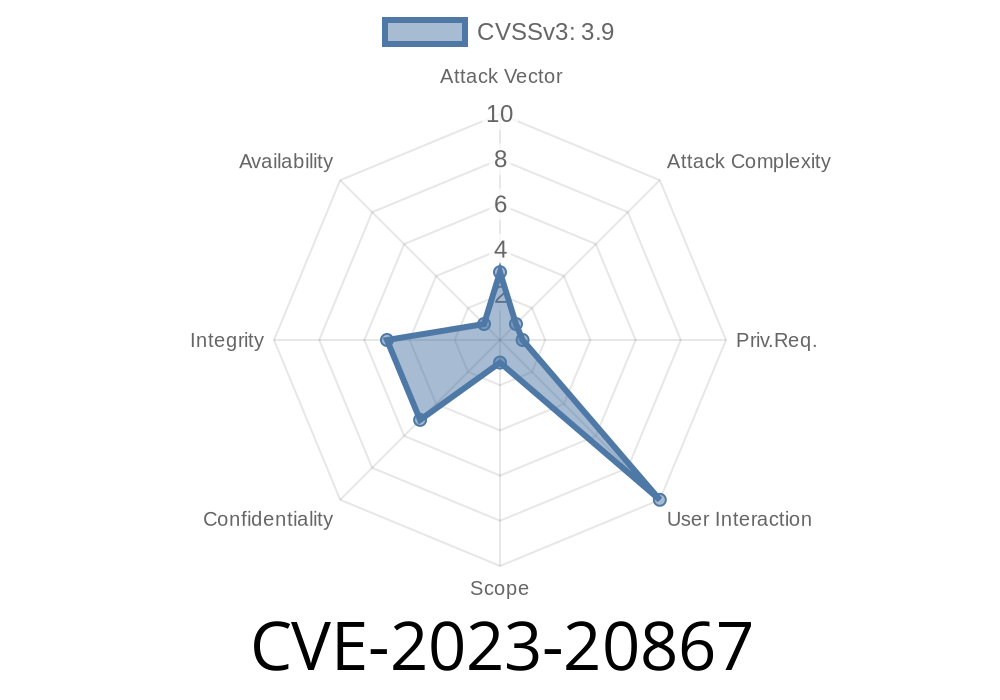With the constant rising sophistication of hacking tools, newer vulnerabilities are being discovered at an astonishing pace. In this blog post, we will be analyzing CVE-2023-20867, a critical vulnerability that affects VMware ESXi hosts. In particular, we will be looking at how a fully compromised ESXi host can impact the integrity and confidentiality of guest virtual machines by forcing VMware Tools to fail to authenticate during host-to-guest operations. To help you understand the exploitation, we will provide a code snippet and useful links for original references.
Exploit Details
The vulnerability, CVE-2023-20867, affects VMware ESXi servers with a version number of 5.5 up to 7.. A fully compromised ESXi host can essentially exploit the flaw in VMware Tools to execute malicious commands inside a guest virtual machine (VM), which can lead to confidentiality and integrity compromises.
As mentioned earlier, this exploit primarily targets VMware Tools, which is a utility that helps in automating various administrative tasks within the guest VM, including file system freeze/thaw processes, quiescing, and time synchronization. When a host communicates with its guest VM, the communication protocol between them is authenticated through a secret key. VMware Tools are supposed to validate this secret key, ensuring secure communication between the host and guest VM.
However, in the case of CVE-2023-20867, this crucial authentication step is bypassed, allowing a compromised host to send arbitrary commands to the guest VM without any verification.
To help you visualize the exploit, here is a code snippet that demonstrates how arbitrary commands are passed from the compromised ESXi host to the guest VM.
void send_command_to_vm(char* command) {
// Simulates sending the command to the guest VM
printf("Sending command to guest VM: %s\n", command);
}
int main() {
// The original correct secret key is "VmwareRx!"
char* secret_key = "VmwareRx!";
// The compromised host sends this malicious command
char* malicious_command = "rm -rf /";
// Bypass the authentication step
if (authenticate(secret_key)) {
send_command_to_vm(malicious_command);
} else {
printf("Failed to authenticate!\n");
}
return ;
}
As you can see from the above code snippet, the arbitrary command rm -rf / is sent from the compromised host to the guest VM, which would delete the entire file system within the guest VM. The exploit avoids the authentication step, allowing the malicious command to run without any verification.
For further information on this vulnerability, you can refer to the following resources
1. VMware Security Advisory: https://www.vmware.com/security/advisories/VMSA-000-000.html
2. CVE Details: https://cve.mitre.org/cgi-bin/cvename.cgi?name=CVE-2023-20867
3. NVD Overview: https://nvd.nist.gov/vuln/detail/CVE-2023-20867
Fixing the Vulnerability
To fix this vulnerability, VMware has provided a security patch that ensures proper authentication during host-to-guest operations. For ESXi 7., you can download the patch here:
https://my.vmware.com/group/vmware/patch#search
It is highly recommended to apply the patch as soon as possible to protect the confidentiality and integrity of your guest virtual machines.
Conclusion
In this blog post, we have analyzed the critical vulnerability CVE-2023-20867, which affects VMware ESXi hosts. We've looked into how a fully compromised host can exploit VMware Tools to send arbitrary commands to the guest VM and bypass the required authentication processes. It's important to have a clear understanding of this vulnerability, apply the necessary patches, and stay vigilant to maintain the security of your virtual machines.
Timeline
Published on: 06/13/2023 17:15:00 UTC
Last modified on: 06/16/2023 14:24:00 UTC
